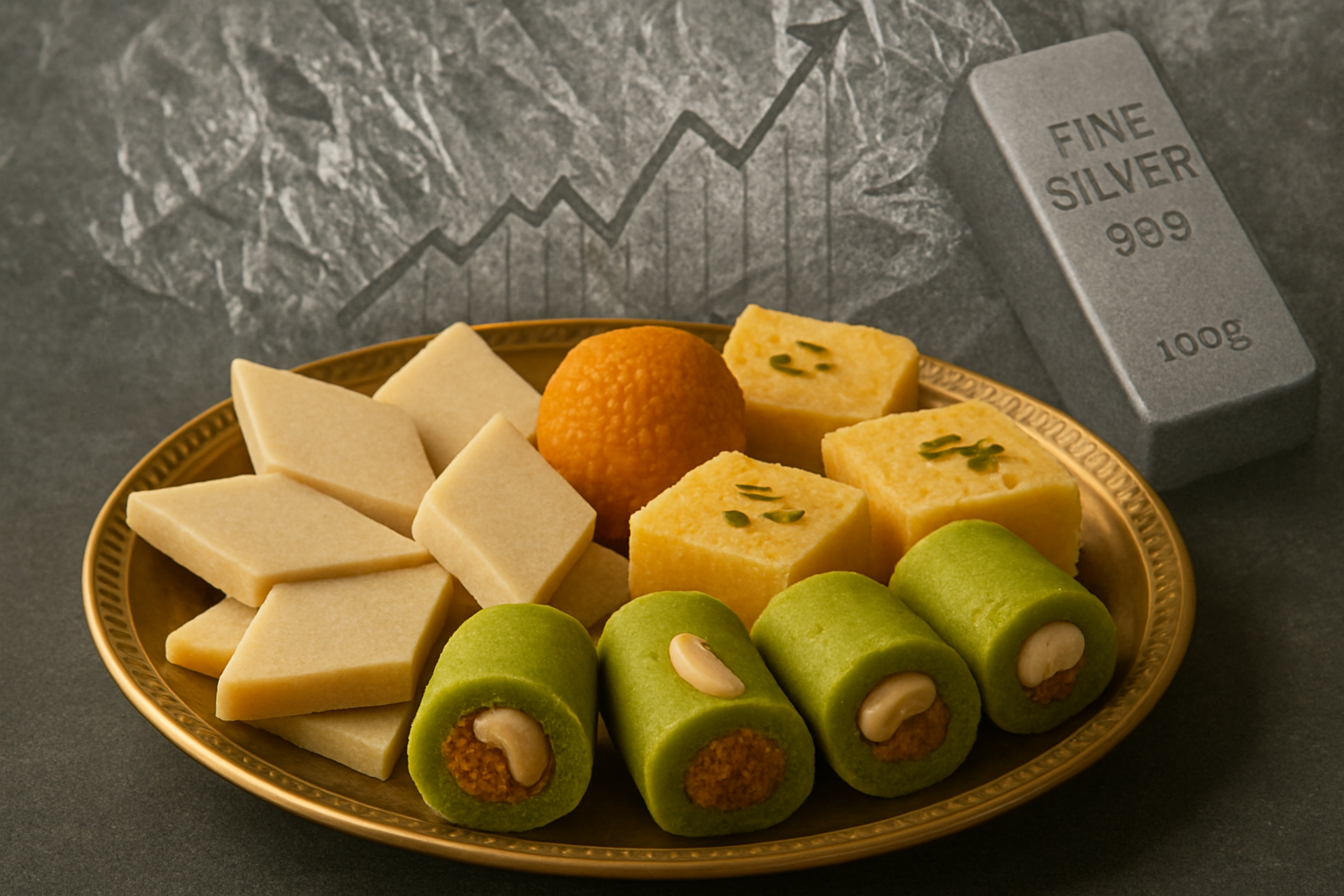Financial News
Silver's Soaring Sparkle Dims Diwali Sweets: Traders Skimp on Traditional Vark Amidst Record Prices

As the festive season of Diwali approaches in 2025, a crucial element of traditional Indian sweets—the delicate silver foil, or 'vark'—is becoming a casualty of unprecedented price surges in the global and domestic silver markets. With silver rates reaching record highs, sweet traders are facing immense pressure, leading many to reduce or even eliminate the use of this iconic adornment, fundamentally altering the presentation and cost of beloved festive treats.
The dramatic escalation in silver prices has created a palpable dilemma for sweet manufacturers, who must now navigate the challenge of maintaining tradition and quality against the backdrop of soaring raw material costs. This economic shift is not merely an inconvenience; it directly impacts consumer budgets for Diwali celebrations and highlights the intricate connection between global commodity markets and local cultural practices.
The High Cost of Tradition: Silver's Ascent and Its Impact on Festive Delights
The current surge in silver prices, as of October 14, 2025, presents a stark picture for industries reliant on the precious metal. In India, the price of 1 kilogram of silver has averaged around ₹1,89,000, with rates climbing even higher in major southern cities like Chennai, Hyderabad, and Kerala, reaching approximately ₹2,06,000 per kilogram. Globally, spot silver touched an all-time high of USD 52.9 per ounce before a slight correction. This monumental rise—a staggering 53% in India so far in 2025—is attributed to a confluence of factors including global supply shortages, robust industrial demand from burgeoning sectors like solar energy and electric vehicles, a weaker US dollar, and strong festive buying.
This unprecedented rally has directly translated into a significant increase in the cost of edible silver foil. Reports indicate that silver vark, which cost ₹5 per sheet last Diwali, has now surged to ₹8. Similarly, the overall cost of vark has seen an additional increase of ₹300 for a quantity that previously cost ₹350. This immediate and substantial hike has put sweet shop owners in a precarious position, as highlighted by a recent Times of India report, "Soaring silver price takes sheen off Diwali sweets as traders skimp on foil," confirming a widespread shortage of vark due to its exorbitant price.
Sweet makers are responding with a variety of strategies to cope with these elevated costs. Many are forced to revise the prices of premium sweets like Kaju Katli and Pista Rolls, passing on a portion of the burden to consumers. Others, such as Delhi's Khoya Mithai, are "reworking designs" of their sweets to minimize the quantity of silver foil used, preserving some aesthetic appeal while managing expenses. Some establishments, like Mumbai's Parsi Dairy Farm, have opted to absorb the 10-15% rise in vark costs to maintain consistent pricing, a testament to their commitment to customers but a strain on their profit margins. Compounding the challenge, any financial relief from reduced Goods and Services Tax (GST) rates on sweets this year has been effectively nullified by the overwhelming increase in silver prices.
Market Dynamics: Identifying Winners and Losers in the Silver Surge
The dramatic ascent of silver prices creates a distinct bifurcation in the financial landscape, producing clear winners and losers across various sectors. On the winning side are entities deeply entrenched in the silver supply chain, particularly silver mining companies and bullion traders. Companies engaged in silver extraction and refining, such as Fresnillo PLC (LSE: FRES) or Pan American Silver Corp. (NASDAQ: PAAS), are likely to see significant boosts in their revenue and profitability as the value of their primary commodity skyrockets. Similarly, investment vehicles focused on precious metals, including silver ETFs, have experienced unprecedented interest, leading some, like Tata Mutual Fund, to temporarily halt inflows due to the sheer magnitude of the surge. These players benefit directly from the increased market value of silver and the speculative demand it generates.
Conversely, the soaring prices present considerable challenges for industries that rely on silver as a raw material, casting them as the primary losers. Sweet manufacturers, ranging from small, family-owned businesses to larger confectionery chains, are bearing the brunt of these costs. Companies like Haldiram's or Bikano, while not exclusively reliant on vark, will feel the impact on their premium product lines. Their profitability is directly eroded by the increased cost of silver foil, forcing them to either absorb losses, raise consumer prices, or seek cheaper alternatives, potentially compromising traditional quality or aesthetics. This squeeze is particularly acute for smaller sweet shops, which operate on tighter margins and have less flexibility to absorb such significant input cost increases. Ultimately, the consumer also stands as a loser, facing higher prices for beloved festive sweets and potentially a diminished traditional experience.
The ripple effect extends beyond direct sweet production. Manufacturers of specialized equipment for vark production or those involved in the traditional artisanal creation of silver foil are also impacted, facing reduced demand for their products as sweet makers scale back. This situation underscores how a commodity price spike can reverberate through an entire ecosystem, affecting not only the direct buyers and sellers but also the ancillary industries and, ultimately, the end consumer's wallet and festive traditions.
Broader Implications: A Glimpse into Commodity Inflation's Reach
The current silver price surge and its impact on Diwali sweets serve as a microcosm of broader industry trends, particularly the pervasive effects of commodity inflation on consumer goods. This event is not an isolated incident but rather fits into a larger pattern of rising raw material costs globally, influenced by geopolitical tensions, supply chain disruptions, and increased industrial demand for critical minerals. The elevated price of silver, driven by its growing utility in green technologies like solar panels and electric vehicles, exemplifies how the energy transition can inadvertently affect traditional consumer markets. This interconnectedness means that a demand spike in one sector can create unexpected pressures in another, far-removed industry.
The ripple effects extend beyond the sweet industry. Other sectors that utilize precious metals for decorative or functional purposes, such as jewelry manufacturing, luxury goods, and even certain pharmaceutical and electronic components, could face similar cost pressures. While silver foil on sweets is a niche application, it highlights the vulnerability of traditional craftsmanship and festive goods to global market forces. Should gold or other precious metal prices follow a similar trajectory, we could see analogous impacts on other cultural or luxury items. This situation also brings to light potential regulatory implications, particularly concerning food safety. The exorbitant cost of pure silver vark increases the temptation for unscrupulous manufacturers to resort to cheaper, potentially harmful adulterants like aluminum foil. This necessitates heightened vigilance from regulatory bodies, such as city health departments, to conduct rigorous inspections and safeguard public health, ensuring the purity and safety of festive treats.
Historically, periods of significant commodity price inflation have always presented challenges for consumer-facing businesses. While direct comparisons to specific historical precedents for silver foil on sweets might be scarce, the broader phenomenon of rising input costs forcing businesses to adapt is well-documented. During times of economic uncertainty or supply shocks, from oil crises to agricultural commodity spikes, industries have consistently faced the choice of absorbing costs, passing them to consumers, or innovating with alternative materials. The current silver situation echoes these past challenges, demonstrating the enduring economic principle that fluctuating raw material costs inevitably reshape market dynamics and consumer choices.
The Path Ahead: Navigating a Shifting Landscape
Looking ahead, the short-term outlook for Diwali 2025 suggests that consumers will continue to face higher prices for silver-adorned sweets, or increasingly, options without the traditional vark. Sweet manufacturers are likely to continue their strategic pivots, further exploring design modifications to minimize vark usage or introducing entirely new product lines that do not rely on silver foil. This immediate adaptation is crucial for maintaining profitability during a peak sales period. The ongoing strength in industrial demand for silver, coupled with potential speculative interest, indicates that a significant price correction may not be imminent, suggesting sustained pressure on sweet traders in the coming months.
In the long term, this event could catalyze a more permanent shift in the confectionery industry. Manufacturers might invest in researching and developing alternative, food-safe decorative elements that mimic the sheen of silver without the prohibitive cost. This could lead to innovative presentations for traditional sweets, potentially creating new market opportunities for suppliers of these alternative materials. Companies specializing in edible glitter, natural colorings, or other creative edible embellishments could find themselves in a growth phase as the industry seeks sustainable and affordable solutions. Such adaptations would not only address the cost issue but also potentially cater to evolving consumer preferences for novelty and cost-effectiveness.
Potential scenarios and outcomes vary. If silver prices stabilize or decline, sweet makers might gradually reintroduce vark more liberally, albeit likely at higher price points than before the surge. However, if prices remain elevated or continue their upward trajectory, the reduction or elimination of silver foil could become a new norm, forever altering the traditional aesthetic of Diwali sweets. This could also lead to a two-tiered market: premium sweets retaining minimal vark at exorbitant prices, and more accessible options foregoing it entirely. The market challenges emerging from this situation will undoubtedly foster innovation, pushing the industry to rethink how tradition can be preserved and presented in an economically viable manner.
Wrapping Up: A Festive Tradition Under Economic Pressure
The soaring price of silver has cast a long shadow over the vibrant preparations for Diwali 2025, significantly impacting the cherished tradition of adorning sweets with delicate silver foil. The key takeaway from this event is the profound influence of global commodity market dynamics on local consumer goods and cultural practices. The dramatic 53% surge in silver prices in India this year, driven by industrial demand and speculative interest, has forced sweet traders to make difficult choices: either absorb escalating costs, pass them on to consumers through higher prices, or reduce the use of the iconic vark. This situation underscores the intricate web connecting international finance with everyday festive celebrations.
Moving forward, the sweet market is likely to remain in a state of flux, characterized by elevated prices for premium, silver-foil-adorned sweets and an increasing prevalence of alternatives. This period of adjustment will test the resilience and adaptability of sweet manufacturers, pushing them towards innovation in presentation and ingredient sourcing. The event also highlights the critical importance of food safety regulations, as the high cost of pure silver could incentivize the use of cheaper, potentially harmful adulterants, necessitating vigilant oversight from health authorities.
For investors, the situation offers several points to watch in the coming months. Monitoring silver commodity prices on exchanges like the MCX and global spot markets will be crucial, as any significant shifts will directly influence the cost of raw materials for various industries. Observing consumer spending patterns during the festive season will provide insights into price elasticity and the willingness of consumers to pay a premium for traditional goods. Furthermore, keeping an eye on the strategies adopted by major confectionery brands and the enforcement of food safety standards will indicate how the industry is adapting to these economic pressures and ensuring product integrity. This Diwali, while the spirit of celebration remains undimmed, the sparkle of silver on sweets will undeniably come at a premium, reflecting a new economic reality.
This content is intended for informational purposes only and is not financial advice
More News
View More





Quotes delayed at least 20 minutes.
By accessing this page, you agree to the following
Privacy Policy and Terms Of Service.



